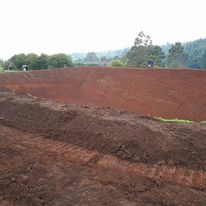When it comes to selecting the appropriate lining system for containment applications, the debate between geosynthetic clay liners (GCLs) and geomembranes is common. Both have unique properties and are used across various industries, including waste management, mining, and water containment. Understanding the differences, advantages, and applications of each can help in making an informed decision for your specific project needs.
Understanding Geosynthetic Clay Liners (GCLs)
Geosynthetic Clay Liners are factory-manufactured hydraulic barriers consisting of bentonite clay sandwiched between layers of geotextiles or geomembranes. Bentonite’s natural swelling properties when hydrated make GCLs effective in creating a low-permeability barrier.
Advantages of GCLs
- Cost-Effective: Generally, GCLs are more cost-effective compared to geomembranes, especially in large-scale applications.
- Self-Healing: The bentonite clay’s ability to swell and self-heal small punctures or holes adds to the durability of GCLs.
- Ease of Installation: GCLs are lighter and easier to install, reducing labor costs and installation time.
- Flexibility: They can conform to uneven surfaces and accommodate differential settlement without compromising performance.
Applications of GCLs
- Landfill Liners and Covers: GCLs are often used in landfill liners and covers due to their low permeability and cost-effectiveness.
- Secondary Containment: They are suitable for secondary containment systems in storage tanks and lagoons.
- Environmental Protection: GCLs are used in applications requiring high environmental protection, such as wastewater treatment plants and canals.
For more information on GCLs, visit Geosynthetic Institute.
Understanding Geomembranes
Geomembranes are impermeable membranes used to control fluid movement in various applications. They are made from synthetic materials such as high-density polyethylene (HDPE), linear low-density polyethylene (LLDPE), or polyvinyl chloride (PVC).
Advantages of Geomembranes
- High Impermeability: Geomembranes offer superior impermeability, making them ideal for critical containment applications.
- Chemical Resistance: They are highly resistant to a wide range of chemicals, making them suitable for hazardous waste containment.
- Long-Term Durability: Geomembranes provide long-term durability and can withstand harsh environmental conditions.
- Customizable: Available in various thicknesses and materials, geomembranes can be customized to meet specific project requirements.
Applications of Geomembranes
- Landfill Liners: Used as primary liners in landfills to prevent leachate migration into the groundwater.
- Mining: Geomembranes are used in mining operations for heap leach pads and tailings ponds.
- Water Containment: They are employed in reservoirs, ponds, and irrigation canals for effective water containment.
For more detailed information on geomembranes, visit International Geosynthetics Society.
Comparing GCLs and Geomembranes
Performance
- Permeability: Geomembranes typically offer lower permeability compared to GCLs, making them more suitable for applications requiring strict fluid containment.
- Chemical Resistance: Geomembranes have higher chemical resistance, which is crucial in hazardous waste containment.
Cost and Installation
- Cost: GCLs are generally more cost-effective, particularly in large-scale projects.
- Installation: GCLs are easier and quicker to install, reducing overall project costs.
Durability and Maintenance
- Durability: Geomembranes provide greater long-term durability and can withstand harsh environmental conditions better than GCLs.
- Maintenance: GCLs offer a self-healing property, which can be advantageous in certain applications.
Making the Right Choice
Choosing between a GCL and a geomembrane depends on the specific requirements of your project. For applications demanding high impermeability and chemical resistance, geomembranes are the preferred choice. However, for projects where cost-effectiveness and ease of installation are critical, GCLs offer significant advantages.
Understanding the unique properties and applications of each lining system is essential for ensuring the success and longevity of your containment project. For more in-depth comparisons and industry insights, consider consulting with geosynthetic experts and referring to reputable sources such as the Geosynthetic Institute and the International Geosynthetics Society.
By carefully evaluating the specific needs of your project and the properties of each material, you can make an informed decision that ensures both performance and cost-efficiency.
By weighing the pros and cons of GCLs and geomembranes, you can determine which lining system best meets the needs of your project. Both materials have their place in the industry and selecting the right one can lead to a more successful and sustainable containment solution.
Originally posted 2024-08-03 13:48:00.

